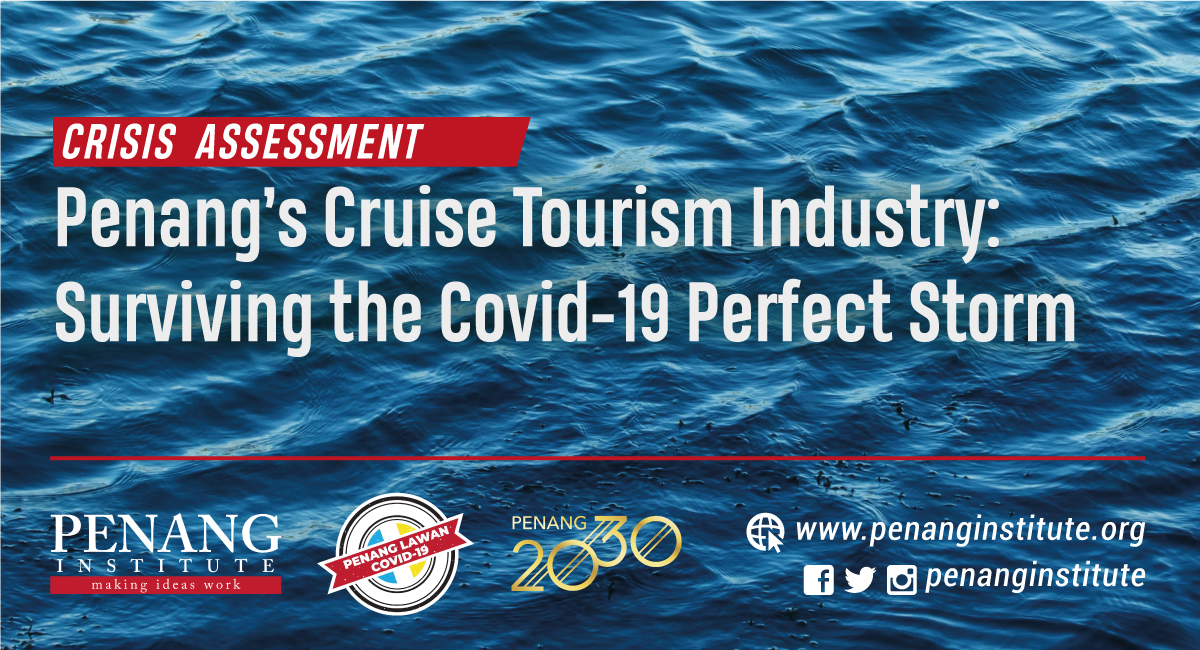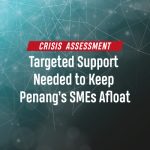EXECUTIVE SUMMARY
- The recent political upheaval and the Covid-19 pandemic have put enormous challenges before Penang’s cruise industry.
- Policy makers in the Penang Cruise Industry need to study seriously the possibility of carrying through idea of homeporting Swettenham Pier.
- Stakeholders in general will have to be bold and imaginative in identifying and embracing new opportunities that will come as the cruise liner market realigns itself worldwide.
- The traditional heavy dependence on foreign tourists should be remedied, and a stronger focus put on stimulated domestic tourism.
- All is not lost if the major stakeholders can work together towards a tight cooperation to sail the cruise industry through the Covid-19 perfect storm.
INTRODUCTION
It was predicted that 2020 would be a blockbuster year for the global cruise tourism industry. Because of its strategic location, Malaysia was expected to be a major beneficiary of this boom.
But all that was before the Covid-19 pandemic hit the world, and the country.
Since being accorded UNESCO World Heritage City Status in 2009, George Town had been enjoying ever-increasing numbers of local and foreign tourist arrivals. With so much to offer the tourism world, Penang then began upgrading its facilities and its reputation as a liveable and charming city. This attracted more and more cruise liners to include Penang and Penang’s Swettenham Pier Cruise Terminal on their itinerary.
Before the pandemic, the cruise industry was the fastest growing sector of the global travel industry, with an increase in demand of 20.5% in the past five years. According to Cruise Lines International Association (CLIA) 2018, around 28.5 million people took a cruise in 2018, up from 26.7 million in 2017. Last year, it was predicted that Penang would perform strongly in the cruise tourism industry for 2020, prompting Penang Port Commission to embark aggressively on a modernization and revitalization plan for Swettenham Pier.
The prospects are exciting. George Town’s heritage site is strategically located only 400 metres from the Swettenham Pier Cruise Terminal. The plan is to turn the terminal into a world-class port-of-call for leisure cruises. On 1 February 2020, Penang Port Commission together with Penang Port Sdn. Bhd and Solaris embarked on a milestone effort to upgrade the Pier within four years. This includes extending the existing wharf to the north by 220 metres. When completed, this will enable two of the world’s largest Oasis-Class ships to berth at any one time. Currently, it can accommodate only one such ship, carrying about 6,700 guests. The terminal building itself will be restructured for efficiency passenger handling, the old godowns will be redeveloped for commercial activities and as a ground transport area (GTA). Once completed, SPCT will accommodate 12,000 passengers, 4,000 more than before.
However, the global outbreak of the novel coronavirus (Covid-19) has created great disquiet about the safety and future of the cruise tourism. Over the space of several weeks, the plight of passengers and crew of several cruise ships stranded at ports around the world following outbreaks aboard ships made headline news, and greatly damaged the industry as well as the idea of cruise tourism as such. The fear within the industry now is that Covid-19 will affect sales for a long time to come, particularly in the Asian market, an especially important market for cruise companies in recent years.
In Malaysia, two major events have affected the planned expansion efforts and may potentially halt the project even before it gets off the ground. The abrupt collapse of the Pakatan Harapan government as well as the Movement Control Orders put in place to control the Covid-19 pandemic have put the expansion project into question.
With Covid-19, as many as 75 million tourism jobs have been affected worldwide, and the disruption to tourism is expected to slash earnings this year by approximately US$2.1 trillion. In the second quarter of 2020, a total of 195 million tourism jobs are expected to be lost globally. In Malaysia, the tourism industry is heading into a perfect storm and this will greatly and negatively impact the growth rate and outlook for the year. The situation is serious indeed.
Therefore, there is great urgency for both the private and public sectors to innovate and cooperate in order to survive the economic slowdown. Major structural changes must now happen within the global cruise industry. Many initiatives are already being looked into, no doubt, and recently, Genting announced that their cruise liners will have mandatory infrared fever screenings at gangways and will require all passengers aged 70 and older to provide doctors’ notes before boarding. Genting will also cut the capacity at entertainment venues by half and have buffet dishes served by staff in masks and disposable gloves. Buffet lines as such may now become a thing of the past.
For their own sake, stakeholders within the industry will need to accept this new scenario, for the changes are game changing, and they will be broad and deep.
Penang has relied heavily for many decades on the tourism industry, and for the tourists guide to the street hawker all the way to hotel owners or cruise operators, it is no longer business as usual.
MAKING PENANG A HOMEPORT
One clear adaptation is for the Penang State Government to start promoting Penang as a homeport for cruise liners. Homeporting will allow domestic tourists to board cruise liners from Penang, and the role of Penang within the cruise industry will no longer be to act as a transiting destination for passengers travelling between other international destinations. To realize this initiative, Penang Port Commission and the Penang State Government will need to work together to restructure the supply chain as well as the infrastructure to cater to this.
For homeporting to happen, the Ministry of Health will also have to set strict health guidelines and put social distancing measures in place for cruise liners to ensure that cruise vacations will not only be fun, but also totally safe.
Domestic tourism in Malaysia may not contribute as much in total tourism revenue compared to inbound tourism (a 41.8 per cent contribution compared to the global average of 71.2 per cent in 2018), but its value has been growing every year (11.4 per cent growth in 2018 compared to 11.1 per cent in 2017). For a long time now, Malaysia’s cruise tourism market has been catering to foreign tourists without strategically engaging the domestic tourism market.
For its own sake, Penang’s tourism industry must start looking beyond the cruise industry for other growth areas. There are local players who believe that Penang will be impacted least among Malaysian states by the pandemic as there are many untapped tourist spots that can offer good choices for tourists in the post-Covid-19 environment. No longer should the industry depend on indoor excursions to museums and exhibitions; the time is ripe to promote outdoor activities such as those that one can do at Escape Outdoor Park or highlight Penang Hill hiking trails, for example; and these can easily be marketed to domestic tourists. What is important is that all these attractions conform to social-distancing rules and stringent health controls.
Tour guides and tour agencies must now start to reskill themselves, and to develop new products, new marketing or new sales approaches. Less overseas travel throughout the world will require tour companies to focus on domestic tourism. Businesses should not expect a V-curve growth rebound that is based on old products and on inbound and outbound tourism; in fact, developing the domestic tourism market promises to be a better bet moving forward.
The Penang State Government should therefore start to proactively attract domestic tourists by working closely with hotels and tour guides to develop the infrastructure and framework needed to stimulate domestic tourism.
Penang should also enhance its alluring hawker food offering by raising public cleanliness and monitoring food safety. This can easily become a new normal, and will contribute to Penang’s reputation as one of the world’s most liveable cities.
The old norm for tourism had been for guided tours to be conducted in big groups, and these groups would often converge at the same selected locations, and simultaneously as well. However, with the new sensitivity about risks of infection, tour guides have no choice but to work closely with operators at tourist spots or restaurants and to spread out their tours and increase and extend their locations in order to avoid dangerous crowding. This should work even better if the Penang State Government is able to identify and develop more locations in the state for tourism, local or foreign.
CONCLUDING REMARKS
Where do we go from here? Unlike the hotel industry, cruise lines may be able to recover more quickly since the operators can redirect ships to new destinations that seem more promising. Cruise passengers are typically very loyal customers and are likely to return after the shock of the outbreak wears off.
Therefore, it is crucial for the State Government to promote Penang as a preferred location for cruise tourists and to develop new well-managed attractions to entice domestic travellers as well as international tourists. Locally themed cruise excursions on world class liners, for example, could be one of Penang’s products. Whatever the case, it is necessary that reputable and stringent health checks be put in place, at Swettenham Pier Cruise Terminal and at any other gathering areas.
Many tour-related companies remain optimistic about their ability to sell flights, package holidays and cruises for 2021. Cruise tourism may not seem promising at this juncture, but all parties should retain some optimism, and look beyond cruise arrivals as people who are on a one-day trip. More value-added components should be extended to cruise passengers so that they feel the possibility to be real that a visit to Penang is a more wholesome tourist experience.
The tourism industry will continue to bleed for a while, but in the meantime, bold and imaginative planning must already be undertaken. Cruise liners, the port operator and the Penang State Government should help bring back the potential of the cruise market, as employer and revenue generator.
The Malaysian government, and the Penang State Government, will need to take the initiative and show optimism that the tourism industry will rebuild itself and meet the new challenges. Greater cooperation between the State Government and stakeholders will determine the success of the cruise industry. As cruise liners reinvent their offerings, Penang has no choice but to re-market itself and upgrade its infrastructure accordingly.
Whatever path is chosen in the near future, health safety issues have to remain a central element in the planning, or it will all be for naught.
You might also like:
![Environmental Policy Lessons to Learn From the Covid-19 Pandemic]()
Environmental Policy Lessons to Learn From the Covid-19 Pandemic
![Domestic Violence and the Safety of Women during the Covid-19 Pandemic]()
Domestic Violence and the Safety of Women during the Covid-19 Pandemic
![Targeted Support Needed to Keep Penang's SMEs Afloat]()
Targeted Support Needed to Keep Penang's SMEs Afloat
![Covid-19: Impact on the Tourist Scuba Diving Industry in Malaysia]()
Covid-19: Impact on the Tourist Scuba Diving Industry in Malaysia
![Covid-19 Set to Aggravate Malaysia’s Skills Mismatch]()
Covid-19 Set to Aggravate Malaysia’s Skills Mismatch







